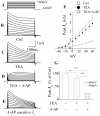HIV-1gp120 induces neuronal apoptosis through enhancement of 4-aminopyridine-senstive outward K+ currents
- PMID: 22016798
- PMCID: PMC3189248
- DOI: 10.1371/journal.pone.0025994
HIV-1gp120 induces neuronal apoptosis through enhancement of 4-aminopyridine-senstive outward K+ currents
Abstract
Human immunodeficiency virus type 1 (HIV-1)-associated dementia (HAD) usually occurs late in the course of HIV-1 infection and the mechanisms underlying HAD pathogenesis are not well understood. Accumulating evidence indicates that neuronal voltage-gated potassium (Kv) channels play an important role in memory processes and acquired neuronal channelopathies in HAD. To examine whether Kv channels are involved in HIV-1-associated neuronal injury, we studied the effects of HIV-1 glycoprotein 120 (gp120) on outward K+ currents in rat cortical neuronal cultures using whole-cell patch techniques. Exposure of cortical neurons to gp120 produced a dose-dependent enhancement of A-type transient outward K+ currents (IA). The gp120-induced increase of IA was attenuated by T140, a specific antagonist for chemokine receptor CXCR4, suggesting gp120 enhancement of neuronal IA via CXCR4. Pretreatment of neuronal cultures with a protein kinase C (PKC) inhibitor, GF109203X, inhibited the gp120-induced increase of IA. Biological significance of gp120 enhancement of IA was demonstrated by experimental results showing that gp120-induced neuronal apoptosis, as detected by terminal deoxynucleotidyl transferase dUTP nick end labeling (TUNEL) assay and caspase-3 staining, was attenuated by either an IA blocker 4-aminopyridine or a specific CXCR4 antagonist T140. Taken together, these results suggest that gp120 may induce caspase-3 dependent neuronal apoptosis by enhancing IA via CXCR4-PKC signaling.
Conflict of interest statement
Figures








Similar articles
-
HIV-1 gp120 enhances outward potassium current via CXCR4 and cAMP-dependent protein kinase A signaling in cultured rat microglia.Glia. 2011 Jun;59(6):997-1007. doi: 10.1002/glia.21171. Epub 2011 Mar 24. Glia. 2011. PMID: 21438014 Free PMC article.
-
Target of HIV-1 Envelope Glycoprotein gp120-Induced Hippocampal Neuron Damage: Role of Voltage-Gated K(+) Channel Kv2.1.Viral Immunol. 2015 Nov;28(9):495-503. doi: 10.1089/vim.2015.0020. Epub 2015 Sep 22. Viral Immunol. 2015. PMID: 26393286 Free PMC article.
-
Methamphetamine potentiates HIV-1gp120-induced microglial neurotoxic activity by enhancing microglial outward K+ current.Mol Cell Neurosci. 2017 Jul;82:167-175. doi: 10.1016/j.mcn.2017.05.009. Epub 2017 May 25. Mol Cell Neurosci. 2017. PMID: 28552341 Free PMC article.
-
Effects of opiates and HIV proteins on neurons: the role of ferritin heavy chain and a potential for synergism.Curr HIV Res. 2012 Jul;10(5):453-62. doi: 10.2174/157016212802138751. Curr HIV Res. 2012. PMID: 22591369 Free PMC article. Review.
-
Moderate ethanol preconditioning of rat brain cultures engenders neuroprotection against dementia-inducing neuroinflammatory proteins: possible signaling mechanisms.Mol Neurobiol. 2010 Jun;41(2-3):420-5. doi: 10.1007/s12035-010-8138-0. Epub 2010 Apr 28. Mol Neurobiol. 2010. PMID: 20422315 Free PMC article. Review.
Cited by
-
Neuroinflammation in HIV-Related Neuropathic Pain.Front Pharmacol. 2021 Apr 20;12:653852. doi: 10.3389/fphar.2021.653852. eCollection 2021. Front Pharmacol. 2021. PMID: 33959022 Free PMC article. Review.
-
Plasma gelsolin protects HIV-1 gp120-induced neuronal injury via voltage-gated K+ channel Kv2.1.Mol Cell Neurosci. 2013 Nov;57:73-82. Mol Cell Neurosci. 2013. PMID: 24416794 Free PMC article.
-
Chemokine co-receptor CCR5/CXCR4-dependent modulation of Kv2.1 channel confers acute neuroprotection to HIV-1 glycoprotein gp120 exposure.PLoS One. 2013 Sep 24;8(9):e76698. doi: 10.1371/journal.pone.0076698. eCollection 2013. PLoS One. 2013. PMID: 24086760 Free PMC article.
-
Voltage-gated potassium channels at the crossroads of neuronal function, ischemic tolerance, and neurodegeneration.Transl Stroke Res. 2014 Feb;5(1):38-58. doi: 10.1007/s12975-013-0297-7. Epub 2013 Nov 19. Transl Stroke Res. 2014. PMID: 24323720 Free PMC article. Review.
-
Role of neuroinflammation in neurodegenerative diseases (Review).Mol Med Rep. 2016 Apr;13(4):3391-6. doi: 10.3892/mmr.2016.4948. Epub 2016 Feb 29. Mol Med Rep. 2016. PMID: 26935478 Free PMC article. Review.
References
-
- McArthur JC, Brew BJ, Nath A. Neurological complications of HIV infection. Lancet Neurol. 2005;4:543–555. - PubMed
-
- Masliah E, Heaton RK, Marcotte TD, Ellis RJ, Wiley CA, et al. Dendritic injury is a pathological substrate for human immunodeficiency virus-related cognitive disorders. HNRC Group. The HIV Neurobehavioral Research Center. Ann Neurol. 1997;42:963–972. - PubMed
-
- Masliah E, Ge N, Achim C, Hansen L, Wiley C. Selective neuronal vulnerability in HIV encephalitis. J Neuropathol Exp Neurol. 1992;51:585–593. - PubMed
Publication types
MeSH terms
Substances
Grants and funding
LinkOut - more resources
Full Text Sources
Medical
Research Materials

